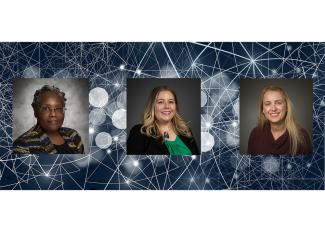Data Science leadership from the U.S. Department of Energy’s (DOE) Office of the Chief information Officer (OCIO) and National Energy Technology Laboratory (NETL) researchers continue to work together to bolster the Department’s geo-data science capabilities through strategic interagency connections and participation in valuable workforce development programs. These efforts support the U.S. Geospatial Data Act of 2018 (GDA) as well as the Federal Data Strategy and help to spark innovation and advance scientific research, catalyze economic opportunity, improve the nation’s public health and protect the environment.
Geospatial data enables critical DOE research, and this location-based information is integral to the greater policy development, evaluation and decision-making that underpin DOE’s mission. For example, awareness of environmental conditions, energy planning and production, hazard mitigation, emergency response and decision support all benefit from carefully curated geospatial data.
Supporting the Geospatial Data Act of 2018
The GDA was passed with the goal of outlining requirements for federal geospatial data governance structures, encouraging organized use and collaboration within agencies, and promoting broader sharing of geospatial data across departments. To help meet the requirements of the GDA, OCIO, as the Department of Energy’s lead office for GDA implementation, established the cross-cutting Geospatial Science Program Management Office (GS-PMO). The GS-PMO, which is co-chaired by OCIO’s Deputy Chief Information Officer for Architecture, Engineering, Technology, and Innovation Pamela Isom, provides the governance structure, strategic direction, mission alignment and communication for the geospatial science and technology implementations within the Department.
Serving as senior agency official for geospatial information (SAOGI), Isom turned to NETL Geo-Data Scientist Jennifer Bauer, Ph.D., to fill the interim position of GS-PMO Geospatial Information Officer because of Bauer’s first-hand knowledge of DOE’s geospatial use and connection to geospatial researchers across the nation.
Bauer joined the NETL team in 2012 and quickly connected to DOE’s GIS user group. “We would meet at geospatial conferences twice a year and share our work and talk about challenges and best practices,” Bauer said. “Then, in 2017, I stepped in as co-chair for that community, hosting and coordinating some of the events.”
Bauer began her detail as interim Geospatial Information Officer in May of last year, and together with Isom, they have taken important steps down the GS-PMO geospatial roadmap. For instance, the group has developed a Geospatial Communications Plan and drafted a Geospatial Data Management Strategy, which will support the GDA and help to build credible, trusted geospatial data in support of the DOE mission.
“The Geospatial Data Management Strategy was a big accomplishment,” said Bauer. “We hope this strategy will enable a collaborative, structured and empowered DOE geospatial community. Such a community can produce, use and share quality geospatial data to develop innovative solutions in support of the nation’s security, energy independence and environmental stewardship.”
The Federal Data Science Training Program
The federal government is committed to leading geo-data science, and one way it is leveraging data as a strategic asset is through the Office of Management and Budget’s (OMB) inaugural Federal Data Science Training program. The program selects two or three high-performing and high-potential employees from each federal agency and teaches them skills to apply data science techniques to enhance data gathering, analysis and visualization-enriched presentations to yield informed for data-driven decisions.
Isom and Bauer had another opportunity to collaborate when they were selected as two of DOE’s participants in the program, which began with online classes in mid-September 2020. Participants will commence their two-month, hands-on capstone project in February 2021.
“We’re still brainstorming ideas for our capstone,” Bauer said. “There are numerous opportunities to leverage DOE data and apply data science and advanced analytics to look at energy challenges and provide insights into the effects of the coronavirus pandemic on energy infrastructure and jobs.”
Isom agreed. “I am concerned about climate change, our readiness for the next pandemic knowing that’s inevitable, and protecting our critical infrastructure,” she said.
Another NETL geo-data scientist, Kelly Rose, Ph.D., is serving as a mentor in the program. Rose and others at the Lab have made significant advancements in data science in the last decade, establishing NETL as a pioneer in the field, as the team developed a wide range of tools and platforms that leverage machine learning (ML) and artificial intelligence (AI) to analyze massive data sets and extract their full value.
Rose has also been named the interim technical director for NETL’s Science-based AI/ML Institute (SAMI). SAMI seeks to foster and leverage NETL’s AI/ML expertise to address applied energy and environmental needs. Participation in OMB’s Federal Data Science Training program aligns to SAMI’s goals, including supporting workforce development to evolve DOE’s energy research competencies.
In addition, the DOE members, which also include a participant from the Western Area Power Administration, are leveraging a valuable new DOE-wide innovation platform designed by Isom called the Innovation Community Center (ICC) as part of their training.
“The ICC is giving context for what we’re learning in our classes and providing valuable information on regulations, laws and governance around data, data management and data use, which is essential as you design projects and as you start to move forward, building architectures and workflows,” Bauer said. “We also appreciate OCIO’s Chief Architect Jayu Wu and the ICC team for ensuring that we have the cloud enclaves and access for developing solutions.”
Read more about how NETL and OCIO are securing big wins for DOE and the nation here.
The U.S. Department of Energy’s National Energy Technology Laboratory develops and commercializes advanced technologies that provide clean energy while safeguarding the environment. NETL’s work supports DOE’s mission to ensure America’s security and prosperity by addressing its energy and environmental challenges through transformative science and technology solutions.




